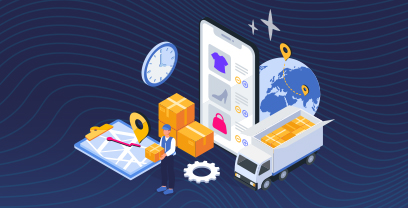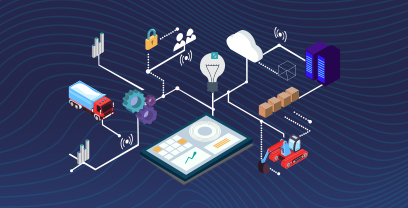According to The Hackett Group, procurement needs in companies across industries have increased 10.6%, indicating a growing productivity gap of 7.4% and an effectiveness gap of 7.8%. These gaps are expected to widen due to a shortage of procurement experts.
Supplier portals can help bridge these gaps by streamlining procurement processes, enhancing efficiency, and reducing reliance on a shrinking human workforce.
Additionally, they offer benefits like cost savings, improved supplier relationships, and better data management, making them an essential tool in an era of limited operational budgets.
In this blog, we provide a comprehensive guide on supplier portals, outlining the benefits of a supplier portal, and offering practical advice on how to choose the best one for your business.
What Is a Supplier Portal?
A supplier portal, also known as vendor portal, is a secure online platform that facilitates communication and collaboration between a company and its suppliers.
This platform serves as a centralized hub where multiple suppliers can manage various aspects of their relationship with the company, including submitting vendor invoices, accessing purchase orders, and updating product information.
The primary purpose of a supplier collaboration portal is to streamline interactions, improve communication and transparency, and enhance the efficiency of the supply chain management process.
Supplier Portals are often part of larger supplier management platforms, which are vital for helping procurement teams and supply chain managers oversee the supplier lifecycle, from onboarding and qualification to performance evaluation and ongoing relationship management.
Effective Supplier Lifecycle Management ensures that businesses can maintain high standards of quality, compliance, and reliability among their suppliers.
How Does Supplier Management Improve Procurement Processes?
According to Ardent Partners, “Automating supplier relationships across the areas of information, performance, and risk management can increasingly impact enterprise operations and overall performance in the months and years ahead.”
To that end, Ivalua suggests building a strategic sourcing program based on four key pillars: spend analysis, sourcing, contract management, and supplier management.
These pillars serve as the foundational sub-processes that drive all sourcing activities within an organization.
Let’s take a look at these four pillars:
- Spend Analysis involves collecting and analyzing spend data to make informed decisions about future purchases. This process helps companies understand their spending patterns, optimize expenditures, and identify cost-saving opportunities.
- Sourcing (or eSourcing) encompasses the entire Source-to-Pay process, where organizations identify, evaluate, and negotiate the procurement of goods and services.
- Contract Management is crucial for maintaining compliance and maximizing the value derived from contracts. This pillar involves managing all contractual documents within a single system of record, ensuring that procurement teams can quickly reference agreements and verify that suppliers meet their obligations.
- Supplier Management focuses on monitoring and enhancing supplier performance across various metrics, including quality, timeliness, and compliance. By using Supplier Performance Management scorecards and managing supplier data, companies can ensure consistent delivery and mitigate risks.
For a more detailed exploration of these four concepts, refer to Ardent Partners’ comprehensive report.
Supplier Networks vs. Supplier Portals – What Are The Differences?
Supplier Networks are designed to allow suppliers to connect with multiple buyers through a single platform, offering the promise of simplified interactions. However, they come with significant drawbacks that can hinder their effectiveness:
- This may disrupt the crucial trust relationship within the supply chain by involving a third party in the payment process.
- The idea of a universal network is unrealistic, especially with the rise of country-specific tax and invoicing systems like PEPPOL (Pan-European Public Procurement On-Line) for public-sector procurement.
- Each buying organization has unique needs and processes, which makes it challenging to standardize interactions on a third-party network.
In contrast, supplier portals provide a direct and secure interface between the buyer and supplier, fostering genuine self-service capabilities and immediate communication.
They serve as a single point of collaboration, enhancing security by minimizing fraud risks and maintaining the direct trust relationship between buyers and their supply chains.
By offering increased supplier adoption, easier maintenance, and a focus on direct communication and trust, supplier portals present a superior solution for managing supplier relationships.
Learn more about Ivalua’s Supplier Portal.
Benefits of a Vendor Portal
Implementing a supplier collaboration portal simplifies supplier registration and onboarding, making it easier for suppliers to connect with the organization. Supplier portals provide a real-time 360-degree view of all supplier information and activity, enabling integrated risk and performance management, as well.
Supplier portals also improve supplier master data by maintaining accurate and up-to-date records, which are crucial for decision-making and compliance. They facilitate enhanced supplier relationships by offering a platform for seamless communication and collaboration.
Additionally, supplier invoice automation and self-service features reduce administrative burdens and allow suppliers to manage their information, invoices, and payments independently.
Check out the Supplier Management Portal datasheet.
Key Considerations When Choosing a Supplier Portal
When selecting a vendor management portal, procurement managers should consider several critical factors:
- Scalability: As your company expands and supplier numbers increase, the portal should be able to handle the added volume without compromising performance. Assess whether the solution can support future growth and integration with other systems.
- Security Features: Look for supplier portal software with robust security measures, such as encryption, multi-factor authentication, and compliance with data protection regulations (e.g., GDPR). Ensuring that sensitive supplier and business data is secure helps mitigate the risk of data breaches and cyber threats.
- User Experience and Interface: Your vendor management portal should offer intuitive navigation, clear instructions, and easy access to necessary features. A well-designed interface increases user adoption and reduces training time, making the platform more effective.
- Customization and Flexibility: Businesses have unique needs, so the supplier portal software should offer customizable features to accommodate specific processes and workflows. Flexibility in adapting the portal to suit particular requirements can enhance operational efficiency and align with business objectives.
- Support and Training: Ensure that the solution provider offers comprehensive support services such as technical assistance, user training, and resources for troubleshooting. Adequate support helps maximize the portal’s utility and ensures users can leverage its full capabilities.
Read our Supplier Risk and Performance Management checklist to get the most out of your SRPM program.
How to Successfully a Implement Supplier Portal
Implementing a supplier management portal is a strategic move that can significantly enhance supply chain collaboration and efficiency. To ensure a successful deployment, follow these best practices.
Assess Your Current Supply Chain Processes
Before selecting a supplier portal, it’s crucial to evaluate your existing supply chain processes. Understand the current challenges, identify inefficiencies, and determine the specific needs of your organization.
Choose the Right Supplier Portal
Select a supplier portal that aligns with your business objectives and integrates well with your existing systems. Consider factors such as scalability, security features, user experience, and customization options. The right portal should be flexible enough to adapt to your evolving business needs and robust enough to protect sensitive data. Don’t forget to evaluate the solution provider as well.
Configure the Portal to Meet Your Specific Needs
Once you’ve chosen a supplier portal, configure it to suit your specific processes and workflows. Customize the interface, set up necessary forms and templates, and define user roles and permissions. This customization ensures that the portal fits seamlessly into your operations and meets the unique demands of your business. No code/low code solutions offer maximum flexibility while allowing you to take full ownership or your portal.
Ensure Seamless Integration with Existing Systems
For a smooth transition, it’s vital that the supplier portal is able to integrate seamlessly with your existing enterprise systems – ERP systems, procurement systems, financial systems and so on – to enable real-time data exchange, reduce manual data entry, and ensure that all departments have access to up-to-date information.
Train Your Team
Provide comprehensive training for all internal users who will interact with the portal. Training should cover the portal’s features, how to use them effectively, and best practices for managing supplier relationships. Ensure that your team is comfortable with the new system and understands how it integrates with their daily tasks.
Onboarding and Training Suppliers
A smooth onboarding process for suppliers is crucial for the portal’s success. Develop a clear communication strategy to inform suppliers about the new portal and its benefits.
Provide training resources, such as manuals and video tutorials, and offer direct support to help suppliers navigate the system. The availability of vendor support during the onboarding phase can significantly enhance the adoption rate among suppliers.
Monitor and Optimize
After implementation, continuously monitor the portal’s performance using metrics and KPIs like supplier compliance rates, the efficiency of transaction processing, and user satisfaction levels. Regularly review these metrics to identify areas for improvement and optimize the portal’s functionality.
Read our blog to learn how to build a winning supplier enablement strategy.
Case Study: How Verallia Achieved 360-degree Visibility of Suppliers Through a Single System
After its spin-off from a larger group, Verallia faced challenges in developing and refining its procurement processes and implementing a new solution. The company needed to accommodate various order types and local business unit preferences while dealing with poor quality of supplier data and an excess of suppliers.
Ivalua’s supplier portal empowered Verallia to achieve 360-degree visibility of vendors and clean up their supplier data. By centralizing supplier master data and integrating third-party sources, Verallia gained better control and achieved high user adoption due to Ivalua’s user-friendly interface.
The company also streamlined its RFQ process and established a centralized database for purchasing contracts, enhancing overall procurement efficiency.
According to Cyrille Chouvet, Supplier Quality & Purchasing Process Manager, Verallia Group, “With Ivalua we finally have 360 degree visibility of suppliers and contracts and automate the full source-to-pay process in a system our users enjoy using.”
Read the full Verallia case study to learn how they achieved 360 degree visibility of suppliers through a single vendor portal.
Improve Your Supplier Management with Ivalua
Ivalua offers a comprehensive suite of tools designed to optimize supplier management, including:
- Supplier Information Management (SIM): Ivalua centralizes supplier data into one platform, ensuring procurement teams have accurate, up-to-date information, including contact details and compliance records. This centralization enhances consistency, reduces errors, and streamlines onboarding processes.
- Supplier Risk Assessment: Ivalua’s advanced tools continuously assess and monitor supplier risks, such as financial stability and compliance, integrating third-party data for a comprehensive risk profile.
- Supplier Performance Evaluations: Customizable scorecards and metrics enable organizations to evaluate suppliers on quality, delivery, cost, and more. Regular assessments identify top performers and areas needing improvement, supporting strategic decision-making.
- Supplier Collaboration: Ivalua facilitates secure, real-time communication and information sharing, enabling suppliers to collaborate on process improvements, thus accelerating innovation and market entry.
Supplier Information Management is a key component of Supplier Management. SIM integrates with modules for Supplier Risk Assessment, Supplier Performance Evaluation, and Supplier Collaboration, and all of the elements work together to provide a unified platform for managing supplier data, assessing risks, monitoring performance, and fostering collaboration.
Learn more about Ivalua’s Supplier Management Software.
Gain a Strategic Advantage With Supplier Portals
Effective supplier management is crucial for enhancing procurement processes, building resilient supply chains, and driving innovation. With a comprehensive supplier management software like Ivalua, organizations can streamline supplier data management, assess and mitigate risks, evaluate performance, and foster collaborative supplier relationships.
This holistic approach to supplier management not only improves efficiency and compliance but also positions companies to adapt swiftly to market changes and capitalize on new opportunities.
Learn more about Ivalua’s supplier portal.
Learn more on how you can manage Supplier Information, Performance, Risk, and Collaboration in One Place in our Supplier Management demo.
Further Reading
You can also Learn more about supplier management by reading the following resources:




